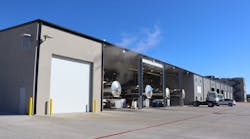Top priorities for businesses in transportation, distribution, supply, and retail markets include fuel margin management, hurricane preparedness, alternative fuels, and US energy independence. At the same time, many of the players in these industry sectors seem to be losing interest in natural gas to fuel their trucks.
These were among the findings of an annual survey conducted by FuelQuest Inc, a leading on-demand software and services company for the global downstream energy industry. The Eye on Energy survey was conducted at FuelQuest’s 10th annual GRAIL conference.
“This year’s GRAIL conference unveiled remarkable insights from key market leaders within the energy industry underscoring unique perspectives around issues impacting fuel price volatility and alternative sources of energy,” said Phil Fraher, president and chief executive officer of FuelQuest. “The 2nd Annual Eye on Energy survey highlighted the need for automated solutions to help downstream organizations better manage operational challenges. It’s this kind of knowledge that helps our company effectively address key customer challenges.”Margin management, fuel invoicing are Top 2014 Business Priorities. With an increased awareness of the new normal of fuel volatility, margin management was ranked as the Number 1 business priority (42%) among respondents this year, while improving the fuel invoicing process closely followed behind at Number 2 (40%). According to FuelQuest calculations, a single truckload of fuel costs approximately $30,000 and on average 10% or more of these invoices have inaccuracies. These costly mistakes highlighted by recent invoicing scandals signal a need for improved invoicing in the industry. Other priorities that are top of mind include business acquisitions (38%) and improved fuel management (32%).
Bulletproof hurricane and disaster preparedness is critical. With the Atlantic hurricane season now under way, retailers, suppliers and fleets are well aware that they should be prepared for hurricane season and are implementing necessary preparedness strategies. Even though reports state that this year’s season could be a quieter year than normal, it is important that businesses not neglect the implementation of emergency preparedness strategies.
According to the FuelQuest Eye on Energy survey, basic preparedness seems to be understood and implemented as over half of respondents have contracted fuel supply (54%) and emergency preparedness plans (52%). However, businesses overwhelmingly do not consider power generators to be a top priority despite their help in emergency situations as witnessed during Hurricane Sandy, with only 22% of respondents currently prepared with installed generators. Furthermore, very few are applying other key strategies critical for optimal, bulletproof preparedness:
--Only 28% have secondary or tertiary supply arrangements
--Less than a quarter (18%) have fuel management automation
Companies reveal strategies to combat fuel price volatility. With today’s fuel volatility and the possibility for an increase in volatility throughout the hurricane season, fuel companies shared strategies that will help mitigate market fluctuations and improve margins that have traditionally been difficult to calculate.
Survey respondents indicated that real-time margin visibility is the best way to combat fuel price fluctuations (34%). Improved demand forecasting ranked second with 28%. Other strategies include:
--Diversified supply portfolio management (26%)
--Greater forecourt automation (18%)
--Automated buy recommendations (16%)
--Improved credit terms (6%)
Natural gas plans remain in a holding pattern. Despite price disparities between compressed natural gas (CNG) and liquefied natural gas (LNG) to traditional diesel fuel, the industry is uncertain about future plans related to these alternative fuels. Thirty-two percent of participants were ‘unsure’ about how CNG and LNG fit into their company’s future plans. However, 28% of respondents indicated that natural gas was part of their existing portfolio. Other responses include:
- Don’t plan to adopt (20%)
- Under review (12%)
- Plan to adopt in the next 1-3 years (6%)
- Plan to adopt in the next 3-5 years (2%)
Industry sees more exploration, less regulation as keys to US energy independence. According to the US Energy Information Administration, last year’s biodiesel production reached 1.35 billion gallons and ethanol production reached 13.8 billion gallons due to the recently released US Renewable Fuel Standards (RFS). GRAIL respondents agree with this call-to-action with 46% citing biofuels as a key driver helping the United States achieve energy self-sufficiency. Respondents also stated increased exploration as the single most important factor (48%) while also citing less governmental regulation (34%).
About the FuelQuest Eye on Energy survey: FuelQuest conducted this survey in-person during its GRAIL conference in Nashville TN from April 22-23, 2014, with more than 180 fuel executives, managers, and professionals with retailers, distributors, suppliers, and fleet-based companies in attendance. More than half of the survey participants are industry leaders who annually buy, sell, or transport more than 300 million gallons of fuel. Now in its tenth year, GRAIL offers invaluable insight into how leaders from their respective industries are addressing critical fuel trends and challenges facing the market today.











